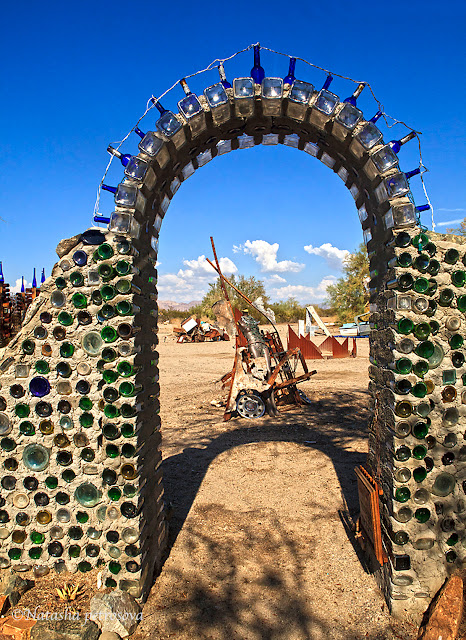A Car entering Slab City
Article and photography by Natasha Petrosova
The story of this town begins in 1942 when United States Navy department obtained 631 acres of desert land east of Niland at the western foot of Chocolate Mountain to use as a camp Dunlap Naval reservation . In 1942 a military post was built as well as 30 -some buildings, swimming pool ,sewage collection and treatment system and concrete fuel tanks. The Marine Corps used camp Dunlap as a training center and 185.000 troops were trained there firing a heavy artillery. After the war ended , the training ended. Camp Dunlap was finally demolished in 1956 . Marines picked up , removed all the buildings , the site was abandoned and all that was left were the foundations of concrete slabs , hence Slab City.
The land now belongs to State of California. The State tried to sell it in a past but without any luck. No one knows how much it would cost to clean it up . Munitions and military waste could be buried underneath the land and the land itself is covered in trash. It could potentially cost too much to clean. Slab City residents say that "This is a land that nobody wants " , this is why no one bothers them to stay here for the past 60 years.
In the early 1960s abandoned camp Dunlap was transformed into a Slab City with over than 10 000 " Snow birds" settling here for the winter months. Some became full times residents and stay through strenuous summer months when the temperature can reach 120 degrees . Slab City was featured in Sean Penn's movie " Into the Wild" in 2007 that gave this city more popularity. 2008 recession brought even more new residents into Slab City.
People migrate to Slab city for different reasons: Some due to poverty because they can not afford to live anywhere else, others to escape the law, retirees trying to stretch their retirement money, and some move here to be free from government and society rules.
Slab City is one of a kind of the community. It's probably the only place in the United States , where one can live for free and be free from laws and regulations because they are not enforced here. This is why they call it " A last free place" and the city lives up to its nickname . "Want to hang out nude in thermal mud baths or skateboard stoned in the bowl of an Olympic-size pool? Go for it. In the mood to construct outlandish pieces of art with scrap metal, dig an SUV-size trench for no particular reason or play 18 holes of golf on a grassless course to the sound of bombs in the distance? This is the place. " One can live here freely and for free. Slab City residents build up the community that works in their own special way with only one rule" live and let live" . But the freedom comes at the price. There is no electricity , water or sewer here. It may be free , but there is no garbage pick up and slab city land is covered in trash. Slab City residents use solar panels to get electricity. There is a concrete hole in a ground supplied by local hot spring and serves as slab city shower.
Slab City has a library, a church, Oasis club and the concert stage called "the range " . The range was built by 20 - year resident Bill Ammon also known as "Builder Bill" where he performs every Saturday night. The range also holds events such as yearly prom night, Halloween and more.
Perhaps the community's most popular Slabber was Leonard Knight a creator of Salvation Mountain that points the entrance to Slab City. Even after his death he still enjoys a local legend status.
References:
Slab City, Here We Come: Living Life Off the Grid in California's Badlands by Jason Motlagh: http://content.time.com/time/nation/article/0,8599,2105597,00.html
Old military check point entrance to slab city
old military check point
Inside miltary check point
Slab City Shower
Slab city Hot Spring
near hot spring
near hot spring
Tree of shoes
Slab City Church
Slab City information board
solar panels
a salb after which sity takes its name
Some art installation
Slab City land is covered with trash
Art Car
the old range abandoned
New Range where Bill Ammon performs every Saturday
The military check point leaving slab City
military check point leaving Slab City






























































